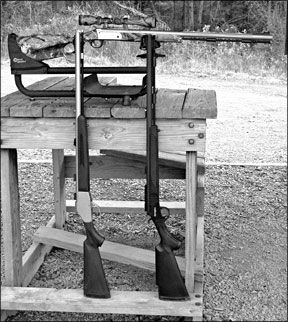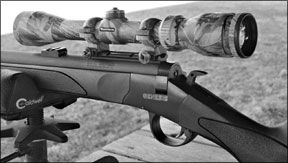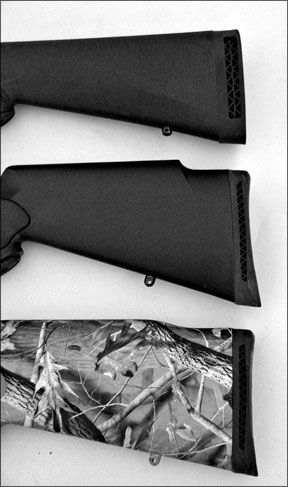There are those wholl tell you that the era of modern muzzleloadingwas spawned in the wave of patriotism and revived historical interest engendered by the 1976 Bicentennial celebration.

You will indeed find that many of the popular sidelock reproduction muzzleloaders were first introduced in that general timeframe and states special blackpowder/primitive weapons hunting seasons started soon thereafter.
But the true birth of “modern muzzleloading” – considering the fact that 97 percent of all muzzleloaders purchased for hunting today are in-line rifles – was in the mid-1980s. Thats when a theretofore unknown Midwestern railroad employee/gunsmith named Tony Knight got the financial backing to produce his futuristic in-line (enclosed hammer as opposed to sidehammer) muzzleloading rifle.
Knights company was, in fact, named Modern Muzzleloading. The first modern (there were in-line designs back in the 18th century) in-line muzzleloader was actually a bolt-action rifle receiver fitted with a screw-out-and-pull-to-cock bolt and a breech plug in the barrel where a chamber would normally be situated in a centerfire design. The enclosed hammer hit a firing pin of sorts that struck the percussion cap, igniting the powder.
The guns were streamlined, lighter and less cumbersome than sidelocks, used faster-twist rifling and, eventually, saboted slugs rather than conical bullets or patched round balls. They felt and shot like rifles; a big factor in their appeal to hunters interested in expanding their hunting opportunities without messing with the primitive aspects of the sidelock guns.
New propellants, synthetic blackpowders, were formulated – later in pellet form of specific weights, new sabot styles designed, and new riflestyles emerged as the market grew. Knight was one of the first to design a gun to accept shotgun primers for ignition rather than percussion or musket caps, and further developed that technology to encase the cap in proprietary plastic disk that made it easier to handle and load.

In the late 1990s Remington brought out a bolt-action rifle, the Model 700ML (actually a Model 700 centerfire receiver and bolt fitted with a muzzleloading barrel and breech plug) that provided easy access to the ignition system while also enclosing it against the weather. Virtually all other manufacturers jumped on the bolt-action bandwagon.
Simplicity then became the goal, since muzzleloading can be a complex and messy. And few years later two stalwart muzzleloading companies, CVA and Thompson Center, introduced simpler exposed-hammer dropping-block designs where a squeeze on the rear of the trigger guard dropped the rear of the action open, exposing the touch hole and primer position.
Soon thereafter companies redesigned the single-shot concept with break-action designs (there had been previous versions in budget guns) where the barrel was actually hinged to the lower aspect of the receiver and dropped open to expose the ignition seat.
We tested three state-of-the-art .50-caliber modern in-lines: The break-action Traditions Pursuit XLT, the modified dropping block Knight Revolution II and the hinged-block Remington Genesis.
How We Tested
Initially each gun was loaded, closed and submerged in a bathtub full of water for a half-hour to test the integrity of the lock-up. When they were removed and taken to the range, the Remington Genesis and Knight Revolution IIfired without hesitation. The Traditions Pursuit XLT, however, failed to fire and had to be unloaded, cleaned and dried before it would function again.

Each gun was then taken to the range for function-and-feel testing, all in turn being fitted with the Chinese-made “Hunter Series” 3-9x40mm variable scope provided by Traditions. All three guns were fitted with Williams-style fiber optic sights on the barrels, and the rear ramps had to be removed to accommodate the 40mm scope bell.
The Traditions and Remington guns, being of identical origin, were fitted with Traditions No. A1789 Weaver-style scope rails, while the Knight wore Weaver two-piece mounts.
Accuracy testing with muzzleloaders is both involved and misleading. Barrel dimensions and rifling depths vary manufacturer-to-manufacturer, which is why so many sell proprietary bullets. And due to manufacturing tolerances and the vagaries of primers, non-enclosed propellent and bullet/sabot fit and makeup, even identical guns, built on the same day in the same factory may prefer different bullet weights/styles and powder charges.
To test a variety of bullets/sabots and charges in each gun to determine the most accurate would be misleading in that there are no guarantees the idea set-up would be even functional in another, otherwise identical, gun.
The Traditions Pursuit came with 250-grain, lead-tip, jacketed APB 200 bullets and red sabots. The Knight Revolution II came with Barnes-built 250-grain copper SBT (Spitzer Boat Tail) bullets and yellow sabots while the Remington Genesis had its own 275-grain Remington Express PT (polymer tip) bullets and red sabots.
Thus we shot each companys proprietary bullet/sabot combinations with two 50-grain Hodgdon Triple-7 pellets and Winchester Triple-7 muzzleloader primers as part of the function testing, and made no further effort to fine-tune accuracy. For consistency, we cleaned each barrel between shots with patches saturated with Traditions WonderLube, then ran a dry patch before reloading.
Again, the shooting proved very little but the Traditions Pursuit grouped the APBs inside 3 inches at 100 yards while the Knight Revolution II consistently put three SBTs well inside two inches at that distance and the Genesis was about the same with the Express PT bullets. We also had some polymer-tipped Barnes Spitfire TMZ on hand, which the Knight grouped at 1.5 inches and the remarkable little Remington Genesis consistently held well inside an inch.
All three guns sported the requisite 27-28 inch, 1-turn-in-28-inches rifling required to fully burn a 150-grain load of synthetic propellent. Recoil was acceptable on all three guns, even when three 50-grain pellets were seated for that very test, even though the guns were of mixed stock design. The Remington Genesis and Knight Revolution II were conventional pistol grip socks while the Traditions Pursuit XLT that we tested was a thumbhole synthetic. All three sported thick, soft recoil butt pads.
Both of the Ardesa guns, the Traditions Pursuit XLT and the Remington Genesis, had easy-loader recesses at the muzzle – smooth-walled, larger-ID chambers ahead of the rifling designed to allow for better alignment and easier starting of the projectile. This can be a good feature if it is milled coaxial to the bore. A surprising percentage in some makes are not, which dooms accuracy. The chambers on the test guns seemed fine, however, as there were no troubling accuracy lapses.
But the Knight Revolution II, without this feature, loaded easier than the other two – probably due to barrel dimension, groove depth and/or lubricity of the metal finish. The Traditions Pursuit XLT also loaded relatively easily, while the Genesis – perhaps coincidentally the only blued barrel – was a bear to load until the barrel was coated with WonderLube.
The triggers on the three guns varied wildly. The Remington Genesis showed an acceptable 3.9-pound average for 10 pulls on the Lyman Digital Trigger Gauge, and – probably not coincidentally – the gun showed the best accuracy in the limited testing.
The Knight, which was a close second in accuracy, needed an average of a much-too-heavy 7.2 pounds to trip the regrettably non-adjustable trigger while the Traditions Pursuit trigger averaged 5.6 pounds in similar testing.
The Knight sported a slightly longer ramrod, probably because the Remington and Traditions models had no receivers in which to extend rod storage space. Length is a factor when using the rod for cleaning between shots in the field, since a barrel-length rod will disappear in the barrel when pushed down to swab all the way to the breech plug. We used a separate range rod during testing. All three guns came with screw-in cleaning jags.
The Knight Revolution requires a proprietary red plastic disk (Full Plastic Jacket), into which the shotgun primer is pressed with the aid of a specialty tool, as part of its ignition system. The Remington and Traditions guns accepted primers alone. The disk is an extra component, which is not always welcome – or commonly available at all dealers – and loading them is an extra step that can understandably be seen as a bother. But the assembled disk/primer is more easily handled than a bare primer, and can be easily stored in a pocket or quick-loader. Dropping it into the gaping maw of the Revolution II breech was simple and efficient, even with gloved hands.
Of the three guns the Remington Genesis was the most maddening to prime, especially with a scope installed. The hinged block opened left, leaving the shooter to reach in from the right with the primer, then thumb it into the port in tight quarters. Gloved hands made it virtually impossible, and the use of a capping tool made it only marginally easier.
The Traditions Pursuit XLT, on the other hand, was extremely easy to prime, since the break action lifted the primer port clear of the receiver with plenty of room to manipulate the primer into position, with or without a capping tool.
One of the ideas behind the simple designs was easy access to the breech plug, which allows through-the-barrel cleaning rather than swabbing blind from the muzzle. Access to the breech plug has long been a signal complaint in muzzleloaders.
Access to the Traditions Pursuit XLT breech plug was easiest of the three, since the wrench could reach it without interference. The Remington Genesis breech plug was only slightly less efficiently accessed once the block was lifted away. The Knight Revolution breech plug was far more accessible than most guns, but was recessed far more into the receiver than that of the Remington and Traditions test mates. All three guns came with tubular breech plug wrenches that made the job fairly simple.
All three guns featured cross-bolt safeties on the trigger guards, sling swivel studs in the stocks and anodized aluminum ram roads that stored in traditional hanging tubes and stock recesses under the barrel.
Knight Revolution II
KR11707C, $415
Modern Muzzleloading, Knight Rifles, was established in southwest Iowa, just across the border from Tony Knights native northern Missouri, in the mid-1980s and has progressed through several owners since. It is currently owned by Pradco (EBSCO Industries) and recently moved manufacturing and headquarters from Centerville, Iowa, to Decatur, Alabama.
A small service shop and marketing office remain in Centerville, and headman Tony Knight is no longer affiliated with the company.
Progressing through the pull-bolt, turn-bolt, disk-fed actions that had Tonys fingerprints on them, Knight Rifles was second only to Black Powder Industries (Spanish-built Connecticut Valley Arms, Winchester Muzzleloaders) in stateside muzzleloading sales. New-at-the-time ownership at Knight brought out the original Revolution in 2003, a deviation from the drop-action Thompson Center Omega, the first design of that particular genre.
The Revolutions receiver is milled from aircraft aluminum, lessening weight without compromising integrity. The guns narrow form, slab sides and two-piece stock/forearm remind one of cowboy saddle guns that Baby Boomers fondly remember from Western movies and TV. No doubt that appeal was part of the Knight designers intentions, but so was simplicity and ease of cleaning and loading. The Revolution design is, ostensibly, a modified lever action/drop block, using a push button at the top of the inside of the pistol grip to release the block, which levers downward and exposes the breech for priming or cleaning.
The entire fire-control system drops with the trigger guard as a unit (Quick Detachable Action), and can be readily detached from the gun entirely by lifting an under panel forward of the guard on the belly of the action. The gun can thus be cleaned internally with ease.
Early versions of the gun experienced problems with blowback through the hammer cover that were tamed by 2004, and the entire fire control system was redesigned for efficiency and consistency in 2005, hence the Revolution II appellation.
The stiff 27-inch barrel sports the industry standard 1-in-28 right-hand rifling, but isnt cryonized like Knights higher-profile Elite series bolt-action disk guns. It is fitted with Williams fiber-optic ramp rear sights and tall front sights, as well as being drilled and tapped for scope mounts.
The Revolution II is available in blued or stainless metal finish with synthetic or laminated wood stocks. The gun is available in .50 or Knights proprietary .52 caliber.
Traditions Pursuit XLT TH
R781033457, $347
Traditions is actually an importer, bringing in double-barreled shotguns from Italian makers Rizzini and Fausti and autoloaders from ATA in Turkey and blackpowder cartridge rifles from Pedersoli in Italy. Its in-line muzzleloaders, like the Pursuit, come from the same Spanish company that makes Remingtons Genesis and the now-defunct Austin & Halleck line – Ardesa.
The Old Saybrook, Connecticut-based Traditions company several years ago sought to carve itself a niche in the low-price muzzleloader market – a move that is increasing dicey for off-shore manufacturers given the Euros strength against the American dollar.
The Pursuit XLT is actually a slight departure and, at $347, is built with style in mind rather than price point. Traditions called its break-open action “Quick Relief” and is so simple that no tools are needed for disassembly. The frame is described as “alloy” with a nickel finish and a European version of the Williams fiber optic rifle sight on the barrel. The 28-inch barrel is ported at the muzzle and featured a 1-in-28 inches rifling twist rate.
The synthetic thumbhole stock is coated with a rubbery Soft Touch coating that does a good job of enhancing grip. The barrel is drilled and tapped for scope mounts right over the chamber. Traditions provided a Weaver-style scope rail, quick-detach rings and a Chinese-made 3-9x40mm scope that wasnt included in the retail quote.
The stock, forearm, scope base, rail, rings and scope are all coated in Realtree Hardwoods camouflage pattern. The nickel-colored barrel was ported on top at the muzzle, the vents being situated just forward of the front sight.
The barrel featured a few ports at the muzzle, but we thought not enough to really reduce muzzle jump or felt recoil. Barrel fluting was similarly largely cosmetic as it did little to reduce the weight of the gun.
The XLT is the top of the Traditions Pursuit line, which is available in blued or stainless metal versions and conventional synthetic or camouflaged stocks. The blued, conventional stock versions often retail as low as $99.
There were no discernible flaws in the stock or metal finish and no tool marks. Checkering was fairly shallow but the Soft Touch finish nevertheless enhanced the grip.
Remington Genesis
No. 89294, $293
Remington dropped out of the muzzleloader business about six years ago when that market went soft and demand for its 700ML – which had been the first-ever bolt-action in-line when introduced in the 1990s – went sour with that market.
We had a 700ML and it was one of the most accurate muzzleloaders weve ever encountered – when it would fire. The model was plagued with ignition problems that were solved (at least in our gun) by a later-edition 209 primer conversion kit.
Countless muzzleloading rifles have passed through here since, encompassing everything from pull-spring, bolt-actions, drop blocks, falling block and break-open designs, but none of them carried a Remington label. Until this year.
Big Green got back into the muzzleloader business in 2006 with the introduction of the Genesis, a unique hinge-blocked, exposed-hammer, .50-caliber rifle made for Remington at the same Artesa factory in Spain that made the handsome-but-now-defunct Austin-Halleck rifles.
Theres been some controversy, both in the industry and even in its own factory, over Remington going off-shore for firearms after nearly 190 years of producing everything itself right here. But youll be hard-pressed to find anyone who can argue with the rugged durability and function of every foreign gun that now wears the Remington trademark. We found the Genesis to be no exception.
Remington made no secret of its aim to get right alongside Thompson Centers splendid Omega in the muzzleloader marketplace, and did so with the 28-inch barreled Genesis, which has suggested retail from $293 to $566, depending on stock material or design and metal finish.
There is no actual action on this hinge-block gun, which reduces weight (Genesis models range from 7.5 to 8 pounds, depending on stock configuration) and length. The fire-control system is instead contained in a unique swinging (instead of dropping, falling, etc.) TorchCam block – a heavy steel affair that contains the firing pin and provides a water-tight seal over the primer in locked position, and simply cams away from the breech plug/primer on a left-hand hinge. In the open position, with the hammer back, the breech plug is exposed totally for easy insertion or depriming of the 209 primer or removal of the plug entirely for cleaning.
The TorchCam lock-up is solid (nearly an inch-thick steel), aided by a detent ball on the right side, and features an easily removed and cleaned firing pin assembly.
Its been proven that you need 28 inches of barrel to take full advantage of the 150-grain charges that are so popular today, and the 1-in-28 twist, shallow-groove rifling in the Genesis barrel mirrors another industry standard. The Genesis comes with black or Mossy Oak conventional or thumbhole synthetic stocks or a gray laminate. Cross-bolt safety on the trigger guard, sling swivel studs, anodized aluminum ramrod, etc.
Granted, a two-piece stock isnt supposed to give the same structural integrity and attendant accuracy as a one-piece (like the TC Omega), but the Genesis doesnt seem to mind. If there is any flex, it cant be much, given the massive underlug and three large bolts that tie the barrel to the receiver.

























